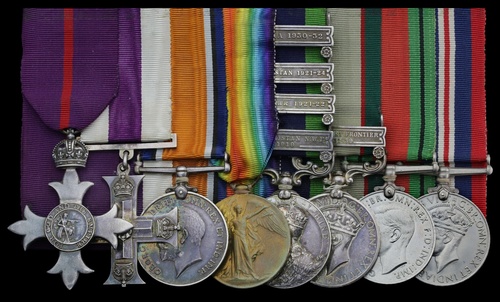Auction: 20001 - Orders, Decorations and Medals - conducted behind closed doors
Lot: 702
A rare inter-war C.I.E., Waziristan M.B.E., North-West Frontier 1919 M.C. group of nine awarded to Lieutenant-Colonel T. I. Stevenson, King's Royal Rifle Corps, attached 2/8th Gurkha Rifles, who was commissioned in Fiji in 1915, severely wounded at Delville Wood in July 1916, and later witnessed extensive service on the North-West Frontier, being thrice decorated
The Most Eminent Order of the Indian Empire, C.I.E., Companion's 3rd type neck Badge, gold and enamel; The Most Excellent Order of the British Empire, M.B.E. (Military) Officer's 1st type breast badge, silver; Military Cross, G.V.R., unnamed as issued; British War and Victory Medals (Lieut. T. I. Stevenson.); India General Service 1908-35, 4 clasps, Afghanistan N.W.F. 1919, Malabar 1921-22, Waziristan 1921-24, Burma 1930-32 (Captn. T. I. Stevenson, 2/8/Gurkhas.); India General Service 1936-39, 1 clasp, North West Frontier 1937-39 (Maj. T. I. Stevenson, 2-8 G R); Defence and War Medals 1939-45, mounted court-style as worn were applicable, the fifth with retaining rod between first and second clasps, the remaining clasps attached by thread as worn, the sixth officially re-impressed, very fine and better (9)
C.I.E. London Gazette 18 July 1933.
M.B.E. London Gazette 13 March 1925:
'For valuable services rendered in the field in connection with military operations in Waziristan, 21st April, 1923 to 31st March, 1924.'
M.C. Edinburgh Gazette 2 December 1919:
'For good leadership and conspicuous gallantry during the withdrawal to camp from Orange Patch Ridge on 15th May 1919. The enemy pressed the retirement heavily, and, being without signallers, he went from one position to another under continual fire and personally arranged the retirement of each party of his force. The retirement was carried out most successfully.'
Thomas Ivor Stevenson was born on 10 September 1896 at Sydney, Australia, the son of Thomas McConnell Stevenson, a planter of the Fiji Islands and Tahiti. Initially home schooled for two years at Suva, Fiji, Stevenson was sent to Ponsonby High School, Auckland, where he took an active role in the School Cadet Corps and Defence Cadet Corps. His papers note experience as a Volunteer Instructor with knowledge of signalling and the maxim gun.
On 1 January 1912, Stevenson was appointed Lieutenant in the Fiji Defence Force, whilst also being employed on the island as a Clerk in the Public Works Department. In March 1912 he transferred to the Medical Department and in October 1914 he was appointed Clerk 4th Class in the Customs Department on a salary of £180 per annum (The Fiji Blue Book, 1917, refers). Commissioned at Suva into the 6th Battalion, King's Royal Rifle Corps on 21 September 1915, Stevenson was considered fit for military service 'after attention to teeth'.
Stevenson arrived in France on 2 January 1916 and was temporarily attached to the 2nd Battalion, 'Fiji Contingent', King's Royal Rifle Corps. He was slightly wounded on 27 February 1916 whilst serving with the 6th Battalion, and began to suffer problems with his right knee. These were exacerbated on 27 July 1916 when he was severely wounded in the right knee, shoulder and forefinger of the left hand by shrapnel from a bomb during the Battalion's attack on Delville Wood; Stevenson was evacuated home from Le Havre to Southampton aboard H.M.H.S. Goorkha on 2 August 1916 and spent the next 3 months on crutches.
He was finally found fit to return to service at a Medical Board meeting held at Lady Northcliffe's Hospital on 8 January 1917, but problems with his knee remained:
'Cannot march any distance'.
Following the cessation of hostilities, Stevenson was seconded for service with the Indian Army on 20 February 1918, being promoted Lieutenant on 4 March 1919. Travelling from Southampton to India, he was first decorated with the Military Cross whilst attached to the 2/8th Gurkha Rifles, Indian Army. Awarded the M.B.E., Stevenson was later promoted Captain and awarded the C.I.E. as Military Intelligence Officer to the 2/8th Gurkha Rifles in the Chittagong District - in what is today south eastern Bangladesh. The Yorkshire Post and Leeds Intelligencer, 18 July 1933, gives mention of the 'Ministerial cheers' which greeted the approval of the awards to Stevenson and Arthur Sheldon Hands, Indian Colonial Service, who had:
'Shown themselves true to our traditions and history. [He had] continuously been guided by a sense of moral duty.'
Sold with extensive copied service record, MIC and research.
Subject to 20% VAT on Buyer’s Premium. For more information please view Terms and Conditions for Buyers.
Sold for
£2,900
Starting price
£1100







